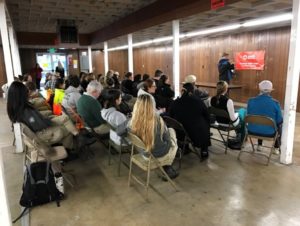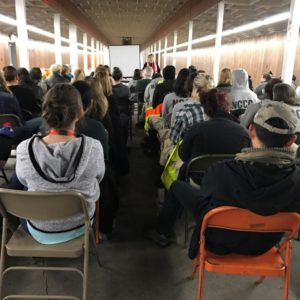Written by Maggie Buckenmayer
Nearly 314,000 Red Cross volunteers are embedded in communities across the country. It isn’t hyperbole to say we couldn’t operate without them, as volunteers carry out 94 percent of our humanitarian work.
It’s important to have trained volunteers ready to go at all times, so if you’re interested in coming on board, we encourage you to start the process now.
But what happens when a disaster suddenly threatens an area like Oroville, California, prompting the quick evacuation of roughly 180,000 residents?
Bringing on Volunteers in a Hurry

While we depend on volunteers for much of our work to meet the immediate emergency needs of affected communities, some unique situations call for additional capacity. If there’s a need and place for volunteers, “spontaneous volunteers” – sometimes called “community based volunteers” – can typically start in entry-level positions once they clear a background check.
Natalie Wren, a nursing student in Chico, California, was one of the first community based volunteers who showed up at the Red Cross shelter at the Silver Dollar Fairgrounds on February 12—the night mandatory evacuation orders were given in the Oroville area.
She learned of the call for health care practitioners from a friend on Facebook and contacted four of her friends, all of whom are in their fifth semester of nursing school. All five rushed to the shelter to volunteer.
She and the other nursing students were placed in roles that are typically inaccessible to many community volunteers, because they had unique and relevant professional experience.
“I volunteered to feel part of something bigger than myself. Helping the shelter residents was why I became a nurse, and having it happen in my own backyard is a crazy experience,” said Natalie, adding that she had learned about Clara Barton and the Red Cross in her first nursing classes and had wanted to become a Red Cross volunteer ever since.
After the customary background check, Natalie earned her official 30-day probationary Red Cross volunteer badge and jumped right into work, helping shelter residents with their health care needs.
The Volunteer Value

Natalie’s story is just one of many volunteer stories from the Oroville Dam response, where numerous new Red Cross volunteers stepped up to the plate. During the two weeks in which the Red Cross operated an evacuation shelter at the Silver Dollar Fairgrounds, over 375 people from the community registered to volunteer for the disaster response.
Niko Marin, another community volunteer, is a student at the fire academy at Shasta College. Niko was excited about using his firefighting training to make him a better Red Cross volunteer.
Eva Marquez, in charge of managing the new volunteers at the Silver Dollar shelter, spoke about the people she had met. “We saw lots of volunteers from Chico State as well as area residents. The turnout was very good.” Eva also reiterated the need for volunteers to make a commitment to their community. On her end, she knows “the key to retention is to perform the background check and engage these volunteers from day one.”
New volunteers will likely always want to come on board after a specific disaster, and we know engaging them is a win-win proposition for the community and for the Red Cross. The Red Cross provides the community with an outlet to channel their desire to assist their neighbors in the aftermath of a disaster. In turn, new community volunteers bring a variety of skills, the motivation to help and their knowledge of their local community.
For the nearly 64,000 disasters the Red Cross responds to every year, volunteers are critical to our ability to provide support to those affected when they need it most.
